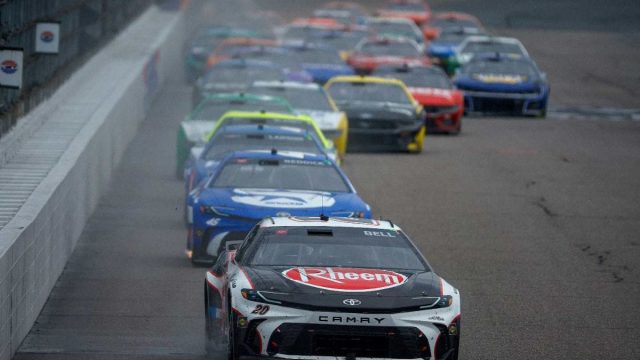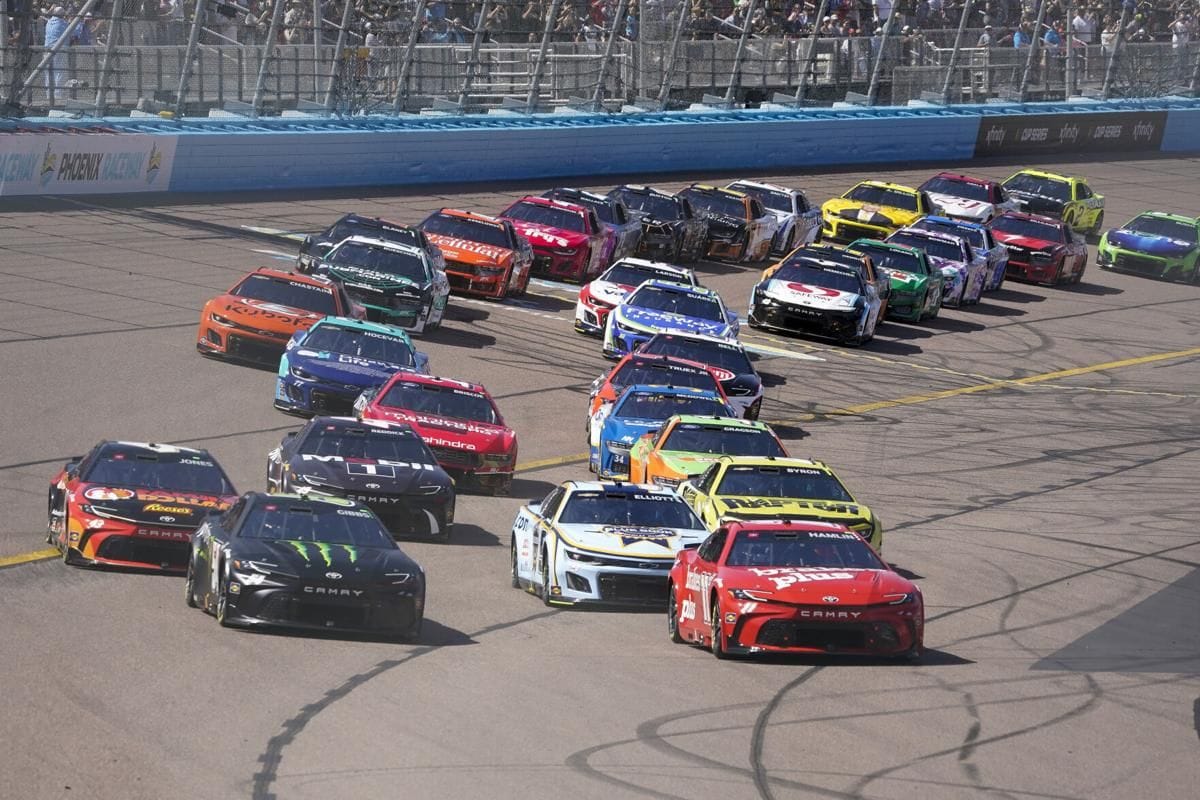NASCAR’s Game-Changing Move on Wet Weather Control: NASCAR’s recent decision to empower teams with the discretion to switch between slick and wet tires during races marks a notable tactical pivot in the sport’s approach to inclement weather. This regulation invites a new layer of tactical complexity and aims to minimize race interruptions, potentially transforming the viewer experience. As fans grapple with the implications of this change, questions arise about its long-term effects on racing dynamics and audience engagement. What does this mean for the future of NASCAR, and how will the teams adapt to this newfound flexibility?
Key Highlights
- NASCAR’s new rule allows teams to choose when to switch to wet tires, enhancing strategic decision-making during races.
- Fans are excited about the potential for uninterrupted racing action, reducing frustrations from past rain delays.
- The flexibility in tire choices during wet conditions aims to improve overall race safety and visibility.
- This rule change reflects NASCAR’s commitment to innovation, potentially attracting both new and lapsed fans.
NASCAR Weather Issues This Season
This season, NASCAR has faced considerable challenges due to inclement weather, with rain disrupting nearly every alternate race, including marquee events like the Daytona 500 and Coca-Cola 600. This has prompted a reevaluation of race management protocols. The frequency of these interruptions has not only frustrated fans but also raised concerns among teams and sponsors regarding the integrity and predictability of race outcomes.
The impact of weather on race operations has been profound. Drivers and crews have had to adapt to unpredictable delays, affecting tactical planning and tire management. Teams that excel in dry conditions may find themselves at a disadvantage when races are blemished by rain. This inconsistency can skew championship standings and undermine the competitive nature that NASCAR is known for.
Moreover, the visibility challenges posed by rain raise safety concerns that cannot be overlooked. Drivers’ ability to navigate wet tracks is compromised, leading to heightened risks and potential accidents. The emotional toll on fans, who invest time and resources to attend or watch these events, cannot be understated either, as they are left disappointed when races are postponed or called off entirely.
As NASCAR progresses through this tumultuous season, the ongoing dialogue surrounding weather management will likely shape future regulations and protocols. Striking a balance between maintaining race integrity and ensuring safety will be paramount. The organization’s forthcoming decisions will be closely scrutinized by all stakeholders, marking a crucial moment in the evolution of NASCAR’s approach to weather-related challenges.
New Rule for Wet-Weather Races
NASCAR’s recent decision to empower teams with the autonomy to choose when to shift from slick to wet tires represents a remarkable shift in race strategy and dynamics, particularly for wet-weather events on oval tracks. This new rule considerably alters the existing protocol, where NASCAR previously mandated that teams pit when rain began to affect the track conditions. By granting teams the discretion to decide the timing of tire changes, NASCAR introduces a new layer of tactical depth that could redefine race outcomes.
The implications of this rule are multifaceted, as teams must now evaluate not only the weather conditions but also the performance of their competitors. The decision to pit could hinge on factors such as tire degradation, lap times, and evolving weather patterns, making in-race analysis more critical than ever.
The community’s reaction to this ruling has been one of astonishment, highlighting a collective anticipation for the tactical complexities it will introduce. As teams adapt to this newfound freedom, the intricacies of wet-weather racing will certainly evolve, setting the stage for an exciting chapter in NASCAR history.
Jeff Gluck’s Clarification
The recent adjustments in tire strategy have led to some confusion within the NASCAR community, prompting prominent motorsports journalist Jeff Gluck to clarify the implications of the new rule concerning wet-weather races. This crucial change allows teams greater autonomy regarding tire changes under caution, enabling them to decide when to utilize their four allotted sets of tires. While this may seem straightforward, the subtleties of the rule have generated a degree of uncertainty among fans and teams similarly.
News: NASCAR will no longer dictate when teams can change tires under caution in a wet-weather oval race. Teams can change tires at their discretion and decide when they use their allotted four sets. Also, pit road strategy (staying out under caution) is now in play.
— Jeff Gluck (@jeff_gluck) August 8, 2024
Gluck’s initial announcement highlighted the noteworthy departure from NASCAR’s previous mandate, where teams were restricted in their tire choices during wet conditions. He emphasized that although teams now have the freedom to change tires at their discretion, all competitors must still adhere to the requirement of using wet tires while conditions warrant. This clarification is critical; it dispels the misconception that some teams may race on dry tires while others remain on wet, thereby preserving the integrity of competition.
Moreover, the introduction of tactical elements—such as the option to stay out under caution for track position—adds a layer of complexity to race strategy. Teams must now weigh the risks and rewards of remaining on wet tires longer, which could impact their comprehensive performance.
Fan Reactions
Excitement among fans has surged following the announcement of NASCAR’s new wet-weather rule, which many view as a vital advancement for the sport. This change is seen as a step towards improving race conditions and ensuring that fans can enjoy uninterrupted action, even in less-than-ideal weather scenarios. The response on social media has been overwhelmingly positive, with fans expressing their approval and anticipation for how this rule will impact future races.
Historically, moments like the red-flag during the Coca-Cola 600, where rain disrupted the flow and outcome of the race, have left fans frustrated. The new rule aims to mitigate such issues, allowing for the possibility of racing in wet conditions, which has been a notable point of disagreement. This shift not only addresses immediate fan concerns but also signals NASCAR’s commitment to improving the complete spectator experience.
While the support is palpable, some fans remain cautiously optimistic, questioning the implementation and effectiveness of the new regulations. Ultimately, as the season progresses, the reactions of both fans and drivers will provide essential insights into the success of NASCAR’s bold initiative to adopt wet weather racing.
Fans’ Optimism for Future Races
With the announcement of the new wet-weather rule, fans are not only expressing satisfaction but also fostering a renewed sense of optimism regarding the future of racing, particularly as they anticipate the upcoming event at Richmond. This significant change, which allows teams greater autonomy in wet conditions, signifies a paradigm shift within NASCAR, empowering drivers and crews to make tactical decisions without being hindered by mandatory pitting.
The excitement surrounding this rule is palpable, as fans celebrate what they perceive as an ‘uncommon NASCAR W.’ The sentiment reflects a broader desire for innovation within the sport, with many expressing hope that similar changes may soon extend to road courses as well. This enthusiasm signals a potential rekindling of interest from lapsed fans who had distanced themselves due to previous restrictive regulations. Comments such as ‘Holy W! NASCAR may be back,’ suggest a collective yearning for the sport to reclaim its former glory.
“This should be for RC’s too.”
“P.S., and by the way, my timeline missed you very much. I hope you didn’t miss us a bit! Excellent decision.”
“That’s what we’ve been waiting for.” – fans reaction
Moreover, the upcoming race at Richmond represents more than just a competition; it embodies a moment of rejuvenation for the NASCAR community. As fans keenly await the resumption of the season, they acknowledge the significance of this rule change in enhancing the viewing experience. The optimism is not merely superficial; it indicates an acknowledgment of NASCAR’s commitment to evolving the sport.
News in Brief: NASCAR’s Game-Changing Move on Wet Weather Control
NASCAR’s recent decision to empower teams with the discretion to shift from slick to wet tires marks a groundbreaking shift in racing strategy.
This regulatory change not only improves competitive dynamics but also aims to boost viewer engagement during adverse weather conditions.
By fostering an environment that encourages tactical decision-making, NASCAR may not only retain its existing fanbase but also attract a new generation of enthusiasts.
This approach could revitalize interest in the sport and ensure its long-term sustainability.
ALSO READ: NASCAR’s Talladega Shakeup: Are They Fixing What’s Not Broken?



